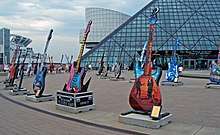Music
Every community in the world has some tradition of music.
Some musical traditions are on the UNESCO Intangible Cultural Heritage list, but many that do not make that list are also important or interesting, at least to some people.
Styles of music
| “ | Music expresses that which cannot be said and on which it is impossible to be silent. | ” |
—Victor Hugo | ||
There are arguments about how to categorize music, but there are some commonly accepted genres:
- Folk music is created and survives through local tradition. There is also an "urban folk" style, fusing folk, popular and other types of music, which was developed starting around the 1960s in various places, including the United States and Latin American countries.
- Classical music has been written down in Europe since no earlier than the 9th century CE, though it had already existed for some time before that. It is roughly divided by period, between the Middle Ages (5th-early 15th century), Renaissance (early 15th-early 17th century), Baroque (late 16th-mid 18th century), the Classical period (early 18th-early 19th centuries), Romantic (19th and early 20th centuries) and contemporary (20th and 21st centuries). Western classical music spread to other continents through colonization and immigration from Europe and cultural exchange, and now exists throughout the world, though it is not uniformly distributed.
.jpg)
- Non-European classical music (or more properly musics) exist in the Arab world (Middle East and North Africa) and Turkey, Iran, Central Asia (e.g., Bukhara), the Indian Subcontinent (with distinct though related Hindustani [Northern Indian, including Pakistan and Bangladesh] and Carnatic [Southern Indian] traditions), Myanmar, Indonesia (with Central Javanese and Balinese styles particularly famous), Malaysia (epitomised by dikir barat, a type of group singing), Thailand, Cambodia, Laos, Vietnam, China, Japan and Korea. Some of these have used their own forms of notation.
- Popular music is made for a mainstream, contemporary audience, including genres such as rock and roll.
- World music combines different musical traditions.
- Blues is a type of African-American music that originated in the Deep South in the 19th century, and would eventually give rise to more modern forms of African-American music such as ragtime, jazz, rhythm and blues, and eventually rock and roll. Memphis is generally considered to be the spiritual home of the blues.
- Jazz is a type of music that originally arose among African-Americans and Creoles in New Orleans in the early 20th century and has since gone through several style changes and become international. Almost every jazz performance includes improvisation or embellishment, with musicians creating their own impromptu melodies, usually based upon the chord changes of a preexisting melody (with the exception of free jazz). There are so many different styles of jazz that they are almost impossible to list; however, the main jazz subgenres are traditional jazz (starting in the early 1900s), big band and swing (1930s and 1940s), bebop (1940s and 1950s on the East Coast but a few years later on the West Coast), soul jazz (late 1950s and early to mid 1960s), and free jazz (1960s to 1980s).
- Electronic dance music is music that is made with synthesizers and drum machines and played at nightclubs, raves and electronic music festivals in many countries in the world. It includes a lot of different subgenres such as for example techno, house, electro or psytrance.
- Country music is a style of American popular music that traces its origins to the rural white working class, thus incorporating folk styles from different parts of Europe. Nashville is considered to be the spiritual home of this type of music.
- Musicals exist at the intersection of theater and music. While musicals can (and have been) written and performed in all styles of music (as long as there is room for text to be transported in any way), there is a certain style that at least some songs in the vast majority of musicals adhere to. While musicals are a huge phenomenon in Great Britain and the United States, they are much less of a factor outside the Anglosphere and often unjustly viewed as "less high brow" than theater or opera in continental Europe and thus usually do not benefit from state sponsoring while Opera and Theater do.
There are also music genres for defined purposes: military music, film music, religious music, children's music, etc.
Itineraries
- The Jazz Track — travel from Boston to New Orleans through cities with important jazz histories
- Music festival circuit — music festivals of all genres are an important reason for travel
- Music in Britain and Ireland — in particular the last half a century or so, the British isles have been one of the world's music epicentres
- Nordic music — five countries with a great scene for folk, classical and popular music
- Salsa dancing in Latin America — salsa dancing is popular around Latin America
Museums

Many museums of history, culture or archeology around the world include some exhibits of musical instruments or artifacts such as manuscripts.
There are also museums or halls of fame for particular genres or countries:
- Nashville has both the Country Music Hall of Fame and a more general Musicians' Hall of Fame
- Cleveland has the Rock and Roll Hall of Fame
- America's Pop Music Hall of Fame
- Calgary has the Canadian Music Hall of Fame
- Stockholm has the Swedish Music Hall of Fame with the ABBA Museum at Djurgården
Elvis Presley's mansion Graceland is in Memphis, and now operates as a museum.